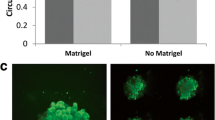Summary
Three related mouse mammary cell lines were cultured in collagen gels and assayed for growth factor responsiveness and interaction via soluble factors. The CL-S1 cell line is nontumorigenic and grows poorly in collagen gel culture. The +SA and −SA cell lines exhibit different degrees of malignant behavior in vivo and have different growth properties in vitro. In collagen gel culture, +SA growth was stimulated by serum but not by epidermal growth factor (EGF), whereas both serum and EGF were required for optimal growth of −SA cells of early passage number as well as CL-S1 cells. −SA cells of later passage repeatedly exhibited a change so as to no longer require serum while retaining EGF responsiveness. [125I]EGF binding analyses indicated that CL-S1 cells bound EGF with less affinity than did −SA cells whereas +SA cells bound almost to ligand. When cell lines were maintained in separate collagen gels but shared the same culture medium, growth of +SA or −SA cells was slightly enhanced in the presence of CL-S1 cells and −SA cell growth was enhanced by the presence of +SA cells. Using the normal rat kidney fibroblast line NRK (clone 49F) as an indicator, serum-containing conditioned media from each cell line and from each pair of cell lines cultured in collagen gels were tested for transforming growth factor (TGF) activity. Both the −SA and CL-S1 lines tested positive for TGF-α production and possibly released a TGF-β activity. These results suggest mechanisms by which cell populations in and around tumors can modify one another’s growth characteristics.
Similar content being viewed by others
References
Absher, M. Hemocytometer counting. In: Kruse, P. F., Jr.; Patterson, M. K., Jr., eds. Tissue culture methods and applications. New York: Academic Press; 1973:395–397.
Anderson, L. W.; Danielson, K. G.; Hosick, H. L. Epithelial cell line and subline established from premalignant mouse mammary tissue. In Vitro 15:841–843; 1979.
Danielson, K. G.; Anderson, L. W.; Hosick, H. L. Selection and characterization in culture of mammary tumor cells with distinctive growth properties in vivo. Cancer Res. 40:1812–1819; 1980.
DeLarco, J. E.; Todaro, G. J. Growth factors from murine sarcoma virus-transformed cells. Proc. Natl. Acad. Sci. USA 75:4001–4005; 1978.
Derynck, R. Transforming growth factor alpha. Cell 54:593–595; 1988.
Fidler, I. J.; Hart, I. R. Biological diversity in metastatic neoplasms: origins and implications. Science 217:998–1003; 1982.
Hallowes, R. C.; Bone, E. S.; Jones, W. A new dimension in the culture of human breast. In: Richards, R. J.; Rajan, K. T., eds. Tissue culture in medical research (II). Oxford and New York: Pergamon Press; 1980;213–220.
Heppner, G. H. Tumor heterogeneity. Cancer Res. 44:2259–2265; 1984.
Imagawa, W.; Tomooka, Y.; Nandi, S. Serum-free growth of normal and tumor mouse mammary epithelial cells in primary culture. Proc. Natl. Acad. Sci. USA 79:4074–4077; 1982.
Jones, W.; Hosick, H. L. Collagen concentration as a significant variable for growth and morphology of mouse mammary parenchyma in collagen matrix culture. Cell Biol. Int. Rep. 10:277–286; 1986.
Kaplan, P. L.; Ozanne, B. Cellular responsiveness to growth factors correlates with a cell’s ability to express the transformed phenotype. Cell 33:931–938; 1983.
Laemmli, U. K. Cleavage of structural proteins during the assembly of the head of bacteriophage T4. Nature 227:680–685; 1973.
Macpherson, I. Soft agar techniques. In: Kruse, P. F., Jr.; Patterson, M. K., eds. Tissue culture methods and applications. New York: Academic Press; 1973:276–280.
Massague, J. The TGF-beta family of growth and differentiation factors. Cell 49:437–438; 1987.
McClure, D. B. Anchorage-independent colony formation of SV40 transformed BALB/c-3T3 cells in serum-free medium: role of cell- and serum-derived factors. Cell 32:999–1006; 1983.
Miller, B. E.; Miller, F. R.; Heppner, G. H. Assessing tumor drug sensitivity by a new in vitro assay which preserves tumor heterogeneity and subpopulation interactions. J. Cell. Physiol. (Suppl.) 3:105–116; 1984.
Miller, B. E.; Miller, F. R.; Leith, J., et al. Growth interaction in vivo between tumor subpopulations derived from a single mouse mammary tumor. Cancer Res 40:3977–3981; 1980.
Moses, H. L.; Tucker, R. F.; Leof, E. B., et al. Type beta transforming growth factor is a growth stimulator and a growth inhibitor. In: Feramisco, J.; Ozanne, B.; Stiles, C.; eds. Cancer cells 3: growth factors and transformation. Cold Spring Harbor, NY: Cold Spring Harbor Laboratory; 1985:65–71.
Nowell, P. C. The clonal evolution of tumor cell populations. Science 194:23–28; 1976.
Peehl, D. M.; Stanbridge, E. J. Anchorage-iddependent growth of normal human fibroblasts. Proc. Natl. Acad. Sci. USA 78:3053–3057; 1981.
Pircher, R.; Lawrence, D. A.; Jullien, P. Latent beta-transforming growth factor in nontransformed and Kirsten sarcoma virus-transformed normal rat kidney cells, clone 49F. Cancer Res. 44:5538–5543; 1984.
Roberts, A. B.; Anzano, M. A.; Lamb, L. C., et al. Isolation from murine sarcoma cells of novel transforming growth factors potentiated by EGF. Nature 295:417–419; 1982.
Scatchard G. The attractions of proteins for small molecules and ions. Ann. NY Acad. Sci. 51:660–672; 1949.
Schnebli, H. P.; Burger, M.; Strasser, F. F., et al. Marked instability of character of cloned epithelial cells. Exp. Cell Biol. 45:24–33; 1977.
Schreiber, A. B.; Winkler, M. E.; Derynck, R. Transforming growth factor-alpha: a more potent angiogenic mediator than epidermal growth factor. Science 232:1250–1253; 1986.
Wray, W.; Boulikas, T.; Wray, V. P., et al. Silver staining of proteins in polyacrylamide gels. Anal. Biochem. 118:197–203; 1981.
Author information
Authors and Affiliations
Additional information
The work was supported by a grant from the American Institute for Cancer Research, by American Cancer Society Institutional grant IN-119, by funds from the Poncin Trust (Seattle-First National Bank), and by grants CA-39611 and CA46885 from the National Institutes of Health, Bethesda, MD.
Rights and permissions
About this article
Cite this article
Hamner, S., Jones, W., Starkey, J.R. et al. Growth factor interactions between mouse mammary cell lines cocultured in collagen gels. In Vitro Cell Dev Biol 25, 1107–1113 (1989). https://doi.org/10.1007/BF02621261
Received:
Accepted:
Issue Date:
DOI: https://doi.org/10.1007/BF02621261




